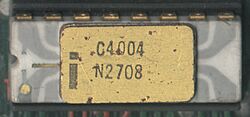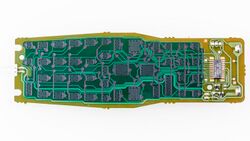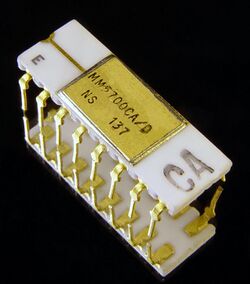4-bit
| Computer architecture bit widths |
|---|
| Bit |
| Application |
| Binary floating-point precision |
| Decimal floating-point precision |
In computer architecture, 4-bit integers, memory addresses, or other data units are those that are 4 bits wide. Also, 4-bit CPU and ALU architectures are those that are based on registers, address buses, or data buses of that size. A group of four bits is also called a nibble and has 24 = 16 possible values. Some of the first microprocessors had a 4-bit word length and were developed around 1970. The TMS 1000, the world's first single-chip microprocessor, was a 4-bit CPU; it had a Harvard architecture, with an on-chip instruction ROM, 8-bit-wide instructions and an on-chip data RAM with 4-bit words.[1] The first commercial microprocessor was the binary-coded decimal (BCD-based) Intel 4004,[2][3] developed for calculator applications in 1971; it had a 4-bit word length, but had 8-bit instructions and 12-bit addresses.
The HP Saturn processors, used in many Hewlett-Packard calculators between 1984 and 2003 (including the HP 48 series of scientific calculators) are "4-bit" (or hybrid 64-/4-bit) machines; as the Intel 4004 did, they string multiple 4-bit words together, e.g. to form a 20-bit memory address, and most of the registers are 64 bits wide, storing 16 4-bit digits.[4][5][6]
The 4-bit processors were programmed in assembly language or Forth, e.g. "MARC4 Family of 4 bit Forth CPU"[7] because of the extreme size constraint on programs and because common programming languages (for microcontrollers, 8-bit and larger), such as the C programming language, do not support 4-bit data types (C requires that the size of the char data type be at least 8 bits,[8] and that all data types other than bitfields have a size that is a multiple of the character size[9]Cite error: Closing </ref> missing for <ref> tag[10]
Modern uses
While 32- and 64-bit processors are more prominent in modern consumer electronics, 4-bit CPUs continue to be used (usually as part of a microcontroller) in cost-sensitive applications that require minimal computing power. For example, one bicycle computer specifies that it uses a "4-bit 1-chip microcomputer".[11] Other typical uses include coffee makers, infrared remote controls,[12] and security alarms.[13]
Use of 4-bit processors has declined relative to 8-bit or even 32-bit processors, as they are hard to find cheaper in general computer suppliers' stores. The simplest kinds are not available in any of them, and others are "non-stock" and more expensive.[14] (A few expensive ones can be found, as of 2014[update], on eBay.)[15][16][17]
Electronics stores still carry, as of 2014[update], non-CPU/non-MCU 4-bit chips, such as counters.
As of 2015[update], most PC motherboards, especially laptop motherboards, use a 4-bit LPC bus (introduced in 1998) to connect the southbridge to the motherboard firmware flash ROM (UEFI or BIOS) and the Super I/O chip.[18][19]
Details
With 4 bits, it is possible to create 16 different values. All single-digit hexadecimal numbers can be written with four bits. Binary-coded decimal is a digital encoding method for numbers using decimal notation, with each decimal digit represented by four bits.
| Binary | Octal | Decimal | Hexadecimal |
|---|---|---|---|
| 0000 | 0 | 0 | 0 |
| 0001 | 1 | 1 | 1 |
| 0010 | 2 | 2 | 2 |
| 0011 | 3 | 3 | 3 |
| 0100 | 4 | 4 | 4 |
| 0101 | 5 | 5 | 5 |
| 0110 | 6 | 6 | 6 |
| 0111 | 7 | 7 | 7 |
| 1000 | 10 | 8 | 8 |
| 1001 | 11 | 9 | 9 |
| 1010 | 12 | 10 | A |
| 1011 | 13 | 11 | B |
| 1100 | 14 | 12 | C |
| 1101 | 15 | 13 | D |
| 1110 | 16 | 14 | E |
| 1111 | 17 | 15 | F |
List of 4-bit processors





- TMS 1000
- Intel 4004
- Intel 4040
- 10NES
- Atmel MARC4 core[20][21] – (discontinued: "Last ship date: March 7, 2015"[22])
- Samsung S3C7 (KS57 Series) 4-bit microcontrollers (RAM: 512 to 5264 nibbles, 6 MHz clock)
- Toshiba TLCS-47 series
- HP Saturn
- NEC μPD75X
- NEC μCOM-4
- NEC (now Renesas) µPD612xA (discontinued), µPD613x, μPD6x[12][23] and μPD1724x[24] infrared remote control transmitter microcontrollers[25][26]
- EM Microelectronic-Marin EM6600 family,[27] EM6580,[28][29] EM6682,[30] etc.
- Epson S1C63 family
- National Semiconductor MAPS MM570X
See also
References
- ↑ TMS 1000 Series Data Manual. Texas Instruments. December 1976. http://blog.kevtris.org/blogfiles/TMS_1000_Data_Manual.pdf. Retrieved July 20, 2013.
- ↑ Mack, Pamela E. (November 30, 2005). "The Microcomputer Revolution". http://www.clemson.edu/caah/history/FacultyPages/PamMack/lec122/micro.htm. Retrieved 2009-12-23.
- ↑ History in the Computing Curriculum. http://www.hofstra.edu/pdf/comphist_9812tla6.pdf. Retrieved 2017-06-22.
- ↑ "The Saturn Processor". http://www.hpmuseum.org/saturn.htm. Retrieved December 23, 2015.
- ↑ "Guide to the Saturn Processor". http://grack.com/writings/hp48/GuidetotheSaturnProcessor.html. Retrieved January 14, 2014.
- ↑ "Introduction to Saturn Assembly Language". http://www.hpcalc.org/details.php?id=1693. Retrieved January 14, 2014.
- ↑ Forth Chips.
- ↑ ISO/IEC 9899:1999 specification. p. 20, § 5.2.4.2.1. http://c0x.coding-guidelines.com/5.2.4.2.1.html.
- ↑ ISO/IEC 9899:1999 specification. p. 37, § 6.2.6.1 (4). http://c0x.coding-guidelines.com/6.2.6.1.html.
- ↑ Ken Shirriff. "The Z-80 has a 4-bit ALU".
- ↑ "Cateye Commuter Manual". http://cateye.com/images/manual/CC-COM10W_ENG_v3.pdf. Retrieved February 11, 2014.
- ↑ 12.0 12.1 μPD67, 67A, 68, 68A, 69 4-bit single-chip microcontroller for infrared remote control transmission
- ↑ Haskell, Richard. "Introduction to Digital Logic and Microprocessors (Lecture 12.2)". http://cse.secs.oakland.edu/haskell/CSE171/Lectures/Fall2004/L12.2%20Microcontrollers.ppt. Retrieved February 11, 2014.
- ↑ "Embedded - Microcontrollers - Integrated Circuits (ICs) - DigiKey". http://www.digikey.com/product-search/en/integrated-circuits-ics/embedded-microcontrollers/2556109?k=4-bit. Retrieved 9 April 2018.
- ↑ "Other Integrated Circuits - eBay". http://www.ebay.com/itm/Toshiba-TMP47C1637N-4bit-MCU-microcontroller-skinny-DIP42-/111294657595?pt=LH_DefaultDomain_0&hash=item19e9adb43b. Retrieved 9 April 2018.
- ↑ "Motorola IC MC14500B / MC14500BCL ( 100% NEW ) - eBay". http://www.ebay.com/itm/Motorola-IC-MC14500B-MC14500BCL-100-NEW-/320837692605. Retrieved 9 April 2018.
- ↑ "KL1868VE1 Soviet CMOS Clone Matsushita MN15500 4bit MCU - eBay". http://www.ebay.com/itm/KL1868VE1-Soviet-CMOS-Clone-Matsushita-MN15500-4bit-MCU-/400212898610?pt=US_Vintage_Computers_Mainframes&hash=item5d2e8c3332. Retrieved 9 April 2018.
- ↑ Scott Mueller. "Upgrading and Repairing Laptops". 2004. p. 176.
- ↑ David S. Lawyer. "Plug-and-Play-HOWTO: LPC Bus" 2007.
- ↑ "MARC4 4-bit Microcontrollers - Programmer's Guide". Atmel. Archived from the original on 2014-12-15. https://web.archive.org/web/20141215021454/http://www.atmel.com/Images/doc4747.pdf. Retrieved January 14, 2014.
- ↑ "MARC4 4-Bit Architecture". Atmel. Archived from the original on May 31, 2009. https://web.archive.org/web/20090531214448/http://atmel.com/products/MARC4/.
- ↑ "Product End-of-Life (EOL) Notification". March 7, 2014. http://www.atmel.com/images/he140901.pdf.
- ↑ μPD6P9 4-bit single-chip microcontroller for infrared remote control transmission
- ↑ μPD17240, 17241, 17242, 17243, 17244, 17245, 17246 4-bit single-chip microcontrollers for small general-purpose infrared remote control transmitters
- ↑ Microcontrollers for Remote Controllers
- ↑ "Mask ROM/ROMless Products 4/8bit Remote Control". Archived from the original on October 28, 2008. https://web.archive.org/web/20081028181219/http://www.necel.com/micro/en/product/mr_48_remocon.html.
- ↑ Robert Cravotta. "Embedded Processing Directory"
- ↑ "EM6580". http://www.emmarin.com/Products.asp?IdProduct=215.
- ↑ "EM6580 low power Flash 4-bit microcontroller"
- ↑ "EM6682"
External links
- Saturn CPU
- "Products: High Performance 4-bit Microcontrollers [ S1C63 family "]. Archived from the original on 2013-07-29. https://web.archive.org/web/20130729191831/http://www.epson.jp/device/semicon_e/product/mcu/high_4bit/.
- Considerations for 4-bit processing
